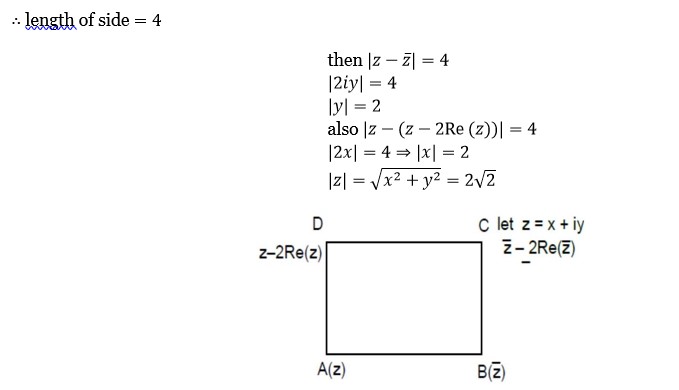Class 11th
Get insights from 8k questions on Class 11th, answered by students, alumni, and experts. You may also ask and answer any question you like about Class 11th
Follow Ask QuestionQuestions
Discussions
Active Users
Followers
New answer posted
2 months agoContributor-Level 9
P: n³ - 1 is even, q: n is odd.
The contrapositive of p → q is ~q → ~p.
~q: n is not odd, i.e., n is even.
~p: n³ - 1 is not even, i.e., n³ - 1 is odd.
⇒ "If n is not odd then n³ - 1 is not even"
⇒ "For an integer n, if n is even, then n³ – 1 is odd."
New answer posted
2 months agoContributor-Level 10
y² = 4x and x² = 4y
any tangent of y² = 4x is y = mx + 1/m
it also tangent for x² = 4y
1/m = -m² ⇒ m = -1
∴ common tangent is y = -x - 1, it also touches x² + y² = c²
∴ 1 = c² ⋅ (1+1) ⇒ c² = 1/2
New answer posted
2 months agoContributor-Level 10
n (C) = 73, n (T) = 65, n (C ∩ T) = x
n (C ∪ T) ≤ 100
⇒ n (C) + n (T) - n (C ∩ T) ≤ 100
⇒ x ≥ 38
n (C ∩ T) ≤ min (n (C), n (T) ⇒ x ≤ 65
⇒ 38 ≤ x ≤ 65
New answer posted
2 months agoLet z = x + iy be a non-zero complex number such that z² = i|z|², where i = √-1, then z lies on the:
Contributor-Level 9
Assuming the equation is (x + iy)² = I (x² + y²)
x² - y² + 2ixy = I (x² + y²)
Compare real and imaginary parts
x² - y² = 0 ⇒ x = y or x = -y
2xy = x² + y²
If x=y, then 2x² = x² + x², which is true for all x.
If x=-y, then -2y² = y² + y² = 2y², which implies 4y²=0, so y=0 and x=0.
The non-trivial solution is x = y.
New answer posted
2 months agoContributor-Level 10
a, b, c are in Andhra Pradesh then
2b = a + c
28 = 3^ (2sin2θ-1) + 3^ (4-2sin2θ)
Put 3^ (2sin2θ) = x
28 = x/3 + 81/x ⇒ x² - 84x + 243 = 0
(x-3) (x-81) = 0
3^ (2sin2θ) = 3 or 3?
2sin2θ = 1 or 4
sin2θ = 1/2
terms are 1, 14, 27,
then T? = 1 + 5 (13)
New answer posted
2 months agoContributor-Level 9
For the parabola y = x², the tangent at (2,4) is given by (y+4)/2 = 2x, which simplifies to 4x - y - 4 = 0.
The equation of a circle touching the line 4x - y - 4 = 0 at the point (2,4) is
(x-2)² + (y-4)² + λ (4x-y-4) = 0.
It passes through (0,1).
∴ (0-2)² + (1-4)² + λ (4 (0) - 1 - 4) = 0
4 + 9 + λ (-5) = 0 ⇒ 13 = 5λ ⇒ λ = 13/5
∴ the circle is x² - 4x + 4 + y² - 8y + 16 + (13/5) (4x-y-4) = 0
x² + y² + (-4 + 52/5)x + (-8 - 13/5)y + (20 - 52/5) = 0
x² + y² + (32/5)x - (53/5)y + 48/5 = 0
∴ centre is (-g, -f) = (-16/5, 53/10).
New answer posted
2 months agoContributor-Level 9
The general term is T? = ¹? C? (K/x²)? (√x)¹?
= ¹? C? K? x? ²? x? /² = ¹? C? K? x? /²
For the constant term, the power of x is 0.
5 - 5r/2 = 0 ⇒ r = 2
The term is T? = ¹? C? · K² = 405
45 · K² = 405
⇒ K² = 9 ⇒ |K| = 3
New answer posted
2 months agoContributor-Level 10
S' = 2¹? + 2? ⋅ 3 + 2? ⋅ 3² + . + 2 ⋅ 3? + 3¹?
G.P. → a = 2¹? , r = 3/2, n = 11
S' = 2¹? ⋅ [ (3/2)¹¹ - 1)/ (3/2 - 1)] = 2¹¹ (3¹¹/2¹¹) - 1)
= 3¹¹ - 2¹¹
New answer posted
2 months agoContributor-Level 10
Negation of x ↔~ y
≡ ~ (x ↔ ~y)
≡ x ↔ ~ (~y)
≡ x ↔ y
≡ (x ∧ y) ∨ (~x ∧ ~y)
Taking an Exam? Selecting a College?
Get authentic answers from experts, students and alumni that you won't find anywhere else
Sign Up on ShikshaOn Shiksha, get access to
- 65k Colleges
- 1.2k Exams
- 679k Reviews
- 1800k Answers

